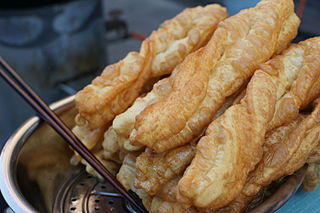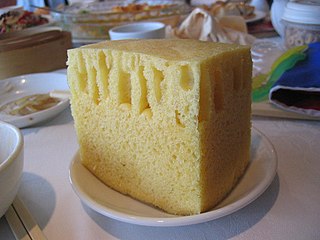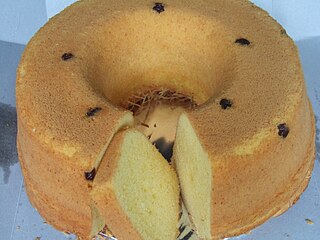 | |
| Alternative names | Egg cake |
|---|---|
| Place of origin | Taiwan |
| Main ingredients | rice flour |
| Variations | Bahulu |
Ji dan gao are Taiwanese sponge cakes served as desserts. [1]
 | |
| Alternative names | Egg cake |
|---|---|
| Place of origin | Taiwan |
| Main ingredients | rice flour |
| Variations | Bahulu |
Ji dan gao are Taiwanese sponge cakes served as desserts. [1]
Ji dan gao are possibly related to the Malay pastry Bahulu. [2] They were introduced to Hawaii by restaurateur Chock Chin in 1998. [3]
They are prepared by steaming sponge cakes made of rice flour, milk, eggs and sugar. [4]

Youtiao, known in Southern China as Yu Char Kway, is a long golden-brown deep-fried strip of wheat flour dough of Chinese origin and also popular in other East and Southeast Asian cuisines.

Kuih are bite-sized snack or dessert foods commonly found in Southeast Asia and China. It is a fairly broad term which may include items that would be called cakes, cookies, dumplings, pudding, biscuits, or pastries in English and are usually made from rice or glutinous rice. In China, where the term originates from, kueh or koé (粿) in the Min Nan languages refers to snacks which are typically made from rice but can occasionally be made from other grains such as wheat. The term kuih is widely used in Malaysia, Brunei, and Singapore, kueh is used in Singapore and Indonesia, kue is used in Indonesia only, all three refer to sweet or savoury desserts.

Nian gao, sometimes translated as year cake or New Year cake or Chinese New Year's cake, is a food prepared from glutinous rice flour and consumed in Chinese cuisine. It is also simply known as "rice cake". While it can be eaten all year round, traditionally it is most popular during the Chinese New Year. It is considered good luck to eat nian gao during this time of the year because nian gao (年糕) is a homonym for "higher year" or "grow every year" (年高), which means "a more prosperous year". The character 年 is literally translated as "year", and the character 糕 (gāo) is literally translated as "cake" and is identical in sound to the character 高, meaning "tall" or "high". In Mandarin, Nian gao (年糕) also is an exact homonym of "sticky cake" (黏糕/粘糕), the character 黏/粘 (nián) meaning "sticky".

A rice cake may be any kind of food item made from rice that has been shaped, condensed, or otherwise combined into a single object. A wide variety of rice cakes exist in many different cultures in which rice is eaten. Common variations include cakes made with rice flour, those made from ground rice, and those made from whole grains of rice compressed together or combined with some other binding substance.

Cha siu bao is a Cantonese baozi (bun) filled with barbecue-flavored cha siu pork. They are served as a type of dim sum during yum cha and are sometimes sold in Chinese bakeries.

Kue is an Indonesian bite-sized snack or dessert food. Kue is a fairly broad term in Indonesian to describe a wide variety of snacks including cakes, cookies, fritters, pies, scones, and patisserie. Kue are made from a variety of ingredients in various forms; some are steamed, fried or baked. They are popular snacks in Indonesia, which has the largest variety of kue. Because of the countries' historical colonial ties, Koeé (kue) is also popular in the Netherlands.

Imagawayaki (今川焼き) is a wagashi often found at Japanese festivals as well as outside Japan, in countries such as Taiwan and South Korea. It is made of batter in a special pan, and filled with sweet azuki bean paste, although it is becoming increasingly popular to use a wider variety of fillings such as vanilla custard, different fruit custards and preserves, curry, different meat and vegetable fillings, potato and mayonnaise. Imagawayaki are similar to dorayaki, but the latter are two separate pancakes sandwiched around the filling after cooking, and are often served cold.

Paper wrapped cake is a type of Chinese cake. It is one of the most common pastries served in Hong Kong. It can also be found in most Chinatown bakery shops. In essence, it is a chiffon cake baked in a paper cup.

Bánh bò is a sweet, chewy sponge cake from Vietnam. It is made from rice flour, water, sugar, and yeast, and has a honeycomb-like appearance on the inside due to the presence of numerous small air bubbles. Coconut milk is also usually a part of the batter, imparting a slight flavor and aroma of coconut. The cake is of Southern Chinese origin, although the Chinese version, called bái táng gāo, does not contain coconut milk. Bánh bò are generally eaten as a dessert, although they may also be consumed as an accompaniment to a meal.

Fa gao, also called fat pan (發粄) by the Hakka, prosperity cake, fortune cake, Cantonese sponge cake, is a Chinese steamed, cupcake-like pastry. Because it is often characterized by a split top when cooked, it is often referred as Chinese smiling steamed cake or blooming flowers. It is commonly consumed on the Chinese new year. It is also eaten on other festivals, wedding, and funerals by the Hakka people.

Sponge cake is a light cake made with eggs, flour and sugar, sometimes leavened with baking powder. Some sponge cakes do not contain egg yolks, like angel food cake, but most of them do. Sponge cakes, leavened with beaten eggs, originated during the Renaissance, possibly in Spain. The sponge cake is thought to be one of the first non-yeasted cakes, and the earliest attested sponge cake recipe in English is found in a book by the English poet Gervase Markham, The English Huswife, Containing the Inward and Outward Virtues Which Ought to Be in a Complete Woman (1615). Still, the cake was much more like a cracker: thin and crispy. Sponge cakes became the cake recognised today when bakers started using beaten eggs as a rising agent in the mid-18th century. The Victorian creation of baking powder by English food manufacturer Alfred Bird in 1843 allowed the addition of butter to the traditional sponge recipe, resulting in the creation of the Victoria sponge. Cakes are available in many flavours and have many recipes as well. Sponge cakes have become snack cakes via the Twinkie.

Bahulu or baulu is a traditional Malay pastry (kue/kuih). It is similar in concept to the madeleine cake, but round in shape and composed of different ingredients. There are three versions available, the most common being bahulu cermai (star-shaped) and the more elusive bahulu gulung and bahulu lapis (layered). Bahulu is believed to be originated in Malay Peninsula during the colonization era and is the corruption of the Malaccan Kristang word, bolu which means cake. It is usually served during Eid al-Fitr as well as during the Lunar New Year.

Bolu kukus is an Indonesian traditional snack of steamed sponge cupcake. The term "bolu kukus" however, usually refers to a type of kue mangkuk that is baked using mainly wheat flour with sugar, eggs, milk and soda, while also using common vanilla, chocolate, pandan or strawberry flavouring, acquired from food flavouring essence. The cake makes use of beaten eggs and soda as an emulsifier, the type of soda often being lemon sparkling water, such as Sprite.

A banana cake is a cake prepared using banana as a primary ingredient and typical cake ingredients. It can be prepared in various manners, including as a layer cake, as muffins and as cupcakes. Steamed banana cake is found in Chinese, Malaysian, Indonesian and Vietnamese cuisine. In the Philippines, the term "banana cake" refers to banana bread introduced during the American colonial period of the Philippines.

Malay sponge cake is a popular dessert cake in Guangdong and in Hong Kong. It usually can be seen at a traditional teahouse in Guangdong and Hong Kong. The cake is made of lard or butter, flour, and eggs, using a bamboo steamer to develop puffiness. An entire Malay sponge cake is a huge yellow round cake, but is generally sold as slices in teahouses. In Hong Kong, where it is very popular, the cake was listed as the "national cake" by the American news channel CNN.

Kue bolu or simply Bolu is an Indonesian term that describes a wide variety of sponge cakes, tarts and cupcakes.